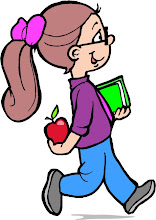Games, activities, books, and web sites that enhanced our learning:
- Three Pots (Games for Math pg 152) -- we used manipulatives to show our numbers, then added K.'s number and my number together for an introduction to adding 2- and 3-digit numbers and re-naming 10 ones as 1 ten.
- Color Order -- I made up this game to practice "first, next, last, before, after, between".
- We each had a set of 10 Unifix Cubes (1 of each color).
- We were situated so we couldn't see the other person's work, but could talk to each other.
- First, I gave instructions as to which color was "first", etc. until all ten cubes were lined up.
- Next we checked to see if our sticks of cubes matched.
- Then it was K.'s turn to give instructions.
- Number Read -- on our way to the park we read 3-digit numbers off license plates
- Bunch of Beans (Games for Math pg 134) -- I used this to practice the 10 more/10 less concept
- Fraction Fun by David A. Adler -- I had planned to cover this book in two days, but we ended up taking three. It has three main activities that help give a good understanding of fractions. Pizza Math (shown below) helps with understanding that the larger the denominator, the smaller the fraction, but the larger the numerator, the larger the section.
- Fabulous Fractions: Games and Activities That Make Math Easy and Fun by Lynette Long -- this is a book I plan to buy before K. hits third grade. Most of it is for third grade and beyond, but I found 3 activities we could do now.
- Sandwich Quarters
- Fraction Stars
- Super Brain Stretchers pg 14 -- we used Jolly Rancher Gummies
- We read Estimation by Penny Dowdy (My Path to Math series), the next day I put some dry noodles in one jar and some cereal in another jar. Then we used the "chunking" method to estimate how many were in each jar.
- For practice with Symmetry, I made papers with shapes on them. K. had to match the papers up that would show symmetry. I taped them together, then she colored them so that the colors were symmetrical also.



- The Triangle Mat came in handy another day, too. One of us would make a subtraction problem. I wrote the problem on a sheet of paper, then showed how to turn it into an addition problem with a missing addend. Then we used shells and turned it into a word problem and solved it.
- For practice adding two digit addends, we each used Unifix cubes (ones) and ten sticks (tens) and made a number, then we put our numbers on the addition mat and I wrote the problem on a sheet of paper. Then we added the ones (renamed ten ones as one ten, if we had that many) and wrote that on the paper, then added the tens (renamed ten tens as one hundred, if there were that many) and wrote that on the paper.
 |
| Our numbers on the mat |
 |
| Renamed ten ones as one ten |
 |
| Counted up the tens |
 |
| Completed written problem |





















No comments:
Post a Comment